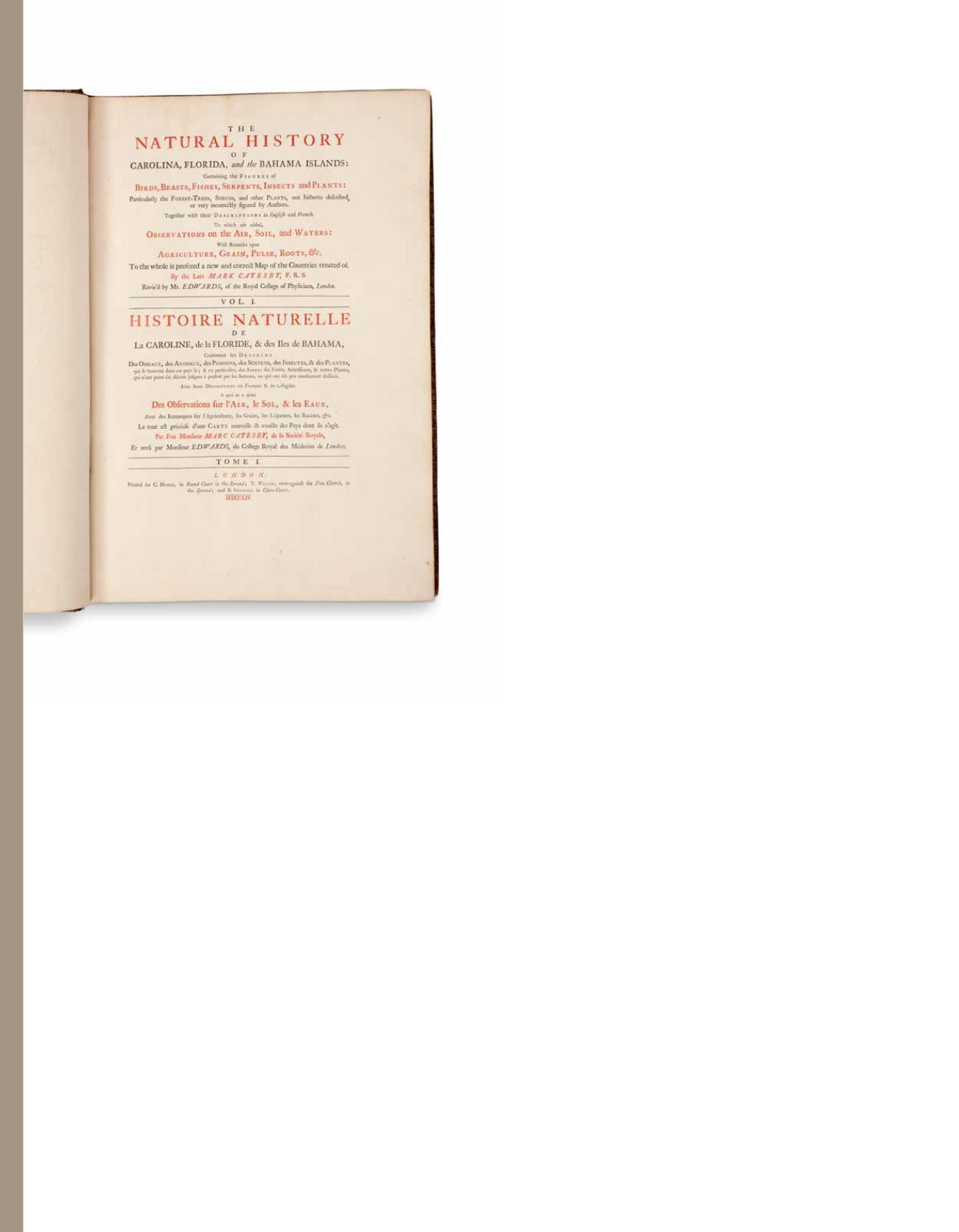

54
les collections aristophil
Botaniste de formation, Catesby voyagea en Virginie en 1712 et y resta
pendant sept ans, expédiant en Angleterre graines et plantes. Encouragé
par Sir Hans Sloane et d’autres, Catesby revint en Amérique en 1722
pour se procurer du matériel pour son Histoire Naturelle ; il voyagea
longuement en Caroline, en Géorgie, en Floride et aux Bahamas,
renvoyant toujours des spécimens à étudier. Sa préface fournit un
compte-rendu de la genèse de son ouvrage. Il y explique sa décision
d’étudier avec Joseph Groupy afin d’apprendre à graver ses planches
par lui-même, pour plus d’économie et de précision.
Catesby décrit dans sa préface sa méthode de travail : « Puisque je ne
suis pas né peintre, j’espère que certaines erreurs de perspective
et autres subtilités seront excusées ; car je conçois humblement que
les plantes et autres choses réalisées simplement, si conçues de
manière exacte, peuvent mieux servir l’objectif de l’Histoire Naturelle
que dessinées avec l’art d’un peintre. En dessinant les plantes, je les ai
toujours représentées fraîches et tout juste cueillies ; et les animaux,
en particulier les oiseaux, je les ai toujours peints vivants (excepté une
poignée d’entre eux) et leur ai donné les attitudes correspondantes
à chaque espèce. Lorsque c’était possible, j’ai adapté les oiseaux
aux plantes dont ils se nourrissent. Les poissons, qui changent de
couleurs lorsqu’ils sont en-dehors de leur élément, je les ai peints
à des moments différents, me procurant une succession de poissons…
Les reptiles vivent de longs mois […] je n’ai donc eu aucune peine
à les peindre vivants ». (Vol. I, p. vi).
L’édition originale fut publiée en dix parties jusqu’en 1743. Les 20
planches de l’appendice furent publiées quatre ans plus tard. Les
corrections de la deuxième édition semblent avoir été entamées
presque immédiatement, sinon simultanément à la publication de
l’Appendix en 1747. Selon Stafleu & Cowan, la deuxième édition fut
publiée entre 1748 et 1756. Des découvertes récentes ont suggéré
qu’il existe de multiples tirages de cette deuxième édition, certains
reprenant des feuillets de la première édition.
In 1712, the English-born artist and naturalist Mark Catesby embarked
on a series of expeditions to the southern colonies of British North
America. Catesby was enthralled by the wildlife of the New World,
and he spent years traveling by foot through parts of present-day
Virginia, Georgia, the Carolinas and the Bahamas. Over the course of
his journeys, he encountered and documented uncountable varieties
of animal and plant life that were entirely unknown to Europeans.
His drawings and written observations were the raw material for an
unprecedented project: a scientific account of previously uninvestigated
wildlife, with illustrations taken from life.
Catesby initially encountered some difficulty in interesting sponsors
in his monumental Natural History. Determined nonetheless to
persevere in his project, and also wishing to maintain control over
the translation of his drawings into print, the artist learned to engrave
copper plates and set out to complete the Natural History himself.
He produced all but two of the plates, and painted the impressions
himself to further insure their fidelity to his models. The result was
the most sweeping, complete and unique natural history study ever
done. Despite Catesby’s initial difficulties in finding subscribers, his
striking finished product received widespread acclaim. Cromwell
Mortimer, Secretary of the Royal Society, declared the publication
to be “the most magnificent work I know since the Art of printing
has been discovered.” Catesby’s charming, distinctive style sets his
work apart from all artists who later followed his example. The overt
simplicity of his compositions is deceiving; the artist arranged each of
his images with great care, often combining seemingly incongruous
elements to create the most artful scene possible. A sense of Catesby’s
enthusiasm for his subjects is palpable in his engravings.
Very few artists were so personally involved in the completion of
a published work, and Catesby’s images convey what the artist must
have experienced in America: the colors and varieties of the exotic
species of birds, fish, animals, insects and plants of the New World.
















